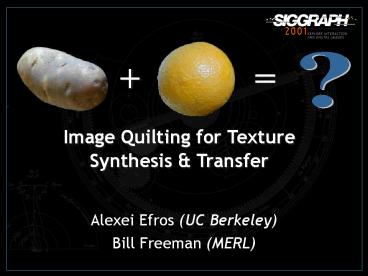Image Quilting for Texture Synthesis - PowerPoint PPT Presentation
Title:
Image Quilting for Texture Synthesis
Description:
Image Quilting for Texture Synthesis – PowerPoint PPT presentation
Number of Views:290
Avg rating:3.0/5.0
Title: Image Quilting for Texture Synthesis
1
Image Quilting for Texture Synthesis Transfer
?
- Alexei Efros (UC Berkeley)
- Bill Freeman (MERL)
2
The Goal of Texture Synthesis
input image
SYNTHESIS
True (infinite) texture
generated image
- Given a finite sample of some texture, the goal
is to synthesize other samples from that same
texture - The sample needs to be "large enough
3
The Challenge
- Need to model the whole spectrum from repeated
to stochastic texture
repeated
stochastic
Both?
4
Texture Synthesis for Graphics
- Inspired by Texture Analysis and Psychophysics
- Heeger Bergen,95
- DeBonet,97
- Portilla Simoncelli,98
- but didnt work well for structured textures
- Efros Leung,99
- (originally proposed by Garber,81)
5
Efros Leung 99
- Shannon,48 proposed a way to generate
English-looking text using N-grams - Assume a generalized Markov model
- Use a large text to compute prob. distributions
of each letter given N-1 previous letters - Starting from a seed repeatedly sample this
Markov chain to generate new letters - Also works for whole words
WE NEED
TO
EAT
CAKE
6
Mark V. Shaney (Bell Labs)
- Results (using alt.singles corpus)
- As I've commented before, really relating to
someone involves standing next to impossible. - One morning I shot an elephant in my arms and
kissed him. - I spent an interesting evening recently with a
grain of salt - Notice how well local structure is preserved!
- Now, instead of letters lets try pixels
7
Efros Leung 99
non-parametric sampling
Input image
Synthesizing a pixel
- Assuming Markov property, compute P(pN(p))
- Building explicit probability tables infeasible
- Instead, lets search the input image for all
similar neighborhoods thats our histogram for
p - To synthesize p, just pick one match at random
8
Efros Leung 99
- The algorithm
- Very simple
- Surprisingly good results
- Synthesis is easier than analysis!
- but very slow
- Optimizations and Improvements
- Wei Levoy,00 (based on Popat Picard,93)
- Harrison,01
- Ashikhmin,01
9
Chaos Mosaic Xu, Guo Shum, 00
input
idea
result
- Process 1) tile input image 2) pick random
blocks and place them in random locations 3)
Smooth edges
Used in Lapped Textures Praun et.al,00
10
Chaos Mosaic Xu, Guo Shum, 00
input
result
- Of course, doesnt work for structured textures
11
Image Quilting
- Idea
- lets combine random block placement of Chaos
Mosaic with spatial constraints of Efros Leung - Related Work (concurrent)
- Real-time patch-based sampling Liang et.al. 01
- Image Analogies Hertzmann et.al. 01
12
Efros Leung 99 extended
non-parametric sampling
Input image
- Observation neighbor pixels are highly correlated
13
block
Input texture
B1
B2
Random placement of blocks
14
Minimal error boundary
overlapping blocks
vertical boundary
15
Our Philosophy
- The Corrupt Professors Algorithm
- Plagiarize as much of the source image as you can
- Then try to cover up the evidence
- Rationale
- Texture blocks are by definition correct samples
of texture so problem only connecting them
together
16
Algorithm
- Pick size of block and size of overlap
- Synthesize blocks in raster order
- Search input texture for block that satisfies
overlap constraints (above and left) - Easy to optimize using NN search Liang et.al.,
01 - Paste new block into resulting texture
- use dynamic programming to compute minimal error
boundary cut
17
(No Transcript)
18
(No Transcript)
19
(No Transcript)
20
(No Transcript)
21
(No Transcript)
22
(No Transcript)
23
(No Transcript)
24
Failures (Chernobyl Harvest)
25
Texture Transfer
- Take the texture from one object and paint it
onto another object - This requires separating texture and shape
- Thats HARD, but we can cheat
- Assume we can capture shape by boundary and rough
shading
Then, just add another constraint when sampling
similarity to underlying image at that spot
26
parmesan
rice
27
28
29
Source texture
Target image
30
31
Portilla Simoncelli
Xu, Guo Shum
input image
Wei Levoy
Image Quilting
32
Portilla Simoncelli
Xu, Guo Shum
input image
Wei Levoy
Image Quilting
33
Homage to Shannon!
Portilla Simoncelli
Xu, Guo Shum
input image
Wei Levoy
Image Quilting
34
Conclusion
- Quilt together patches of input image
- randomly (texture synthesis)
- constrained (texture transfer)
- Image Quilting
- No filters, no multi-scale, no one-pixel-at-a-time
! - fast and very simple
- Results are not bad































